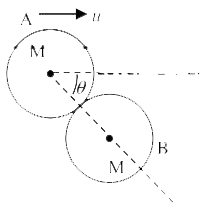A smooth sphere A of mass m collides elastically with an identical sphere B at rest. The velocity of A before collision is 8m/s in a direction making 60∘ with the line of centres at the time of impact, Then
The spher A comes to rest after collision
The sphere B will move with a speed of 8 m/s after collision
The directions of motion of A and Bafter collision are at tight angles
The speed of B after collsion is 4 m/s
To solve the problem of the elastic collision between two identical spheres, we can follow these steps:
Step 1: Understand the Initial Conditions
- Sphere A has a mass m and is moving with a velocity of 8m/s at an angle of 60∘ to the line of centers at the time of impact.
- Sphere B is at rest.
Step 2: Resolve the Velocity of Sphere A
We need to resolve the velocity of sphere A into two components:
- Along the line of impact (x-direction)
- Perpendicular to the line of impact (y-direction)
Using trigonometric functions:
- The component of velocity along the line of impact (x-direction):
vAx=8cos(60∘)=8×12=4m/s
- The component of velocity perpendicular to the line of impact (y-direction):
vAy=8sin(60∘)=8×√32=4√3m/s
Step 3: Apply the Conservation of Momentum and Kinetic Energy
In an elastic collision between two identical masses, the velocities along the line of impact are exchanged. Therefore:
- After the collision:
- Sphere A will have a velocity of 0m/s along the line of impact.
- Sphere B will take the velocity of sphere A along the line of impact, which is 4m/s.
Step 4: Determine the Final Velocities
- The final velocity of sphere A along the line of impact:
vAxf=0m/s
- The final velocity of sphere B along the line of impact:
vBxf=4m/s
- The component of sphere A's velocity perpendicular to the line of impact remains unchanged:
vAyf=4√3m/s
Step 5: Analyze the Final Conditions
- Sphere A moves with a velocity of 4√3m/s perpendicular to the line of impact.
- Sphere B moves with a velocity of 4m/s along the line of impact.
Conclusion
- Sphere A does not come to rest; it has a velocity of 4√3m/s perpendicular to the line of impact.
- Sphere B moves with a velocity of 4m/s along the line of impact.
- The directions of motion of A and B after the collision are at right angles to each other.
Final Answers
- Sphere A's final speed: 4√3m/s (perpendicular).
- Sphere B's final speed: 4m/s (along the line of impact).
- The direction of motion of A and B after the collision are at right angles.
- Sphere A has a mass m and is moving with a velocity of 8m/s at an angle of 60∘ to the line of centers at the time of impact.
- Sphere B is at rest.
We need to resolve the velocity of sphere A into two components:
- Along the line of impact (x-direction)
- Perpendicular to the line of impact (y-direction)
- The component of velocity along the line of impact (x-direction):
vAx=8cos(60∘)=8×12=4m/s
- The component of velocity perpendicular to the line of impact (y-direction):
vAy=8sin(60∘)=8×√32=4√3m/s
In an elastic collision between two identical masses, the velocities along the line of impact are exchanged. Therefore:
- After the collision:
- Sphere A will have a velocity of 0m/s along the line of impact.
- Sphere B will take the velocity of sphere A along the line of impact, which is 4m/s.
- The final velocity of sphere A along the line of impact:
vAxf=0m/s
- The final velocity of sphere B along the line of impact:
vBxf=4m/s
vAyf=4√3m/s
- Sphere A moves with a velocity of 4√3m/s perpendicular to the line of impact.
- Sphere B moves with a velocity of 4m/s along the line of impact.
- Sphere A does not come to rest; it has a velocity of 4√3m/s perpendicular to the line of impact.
- Sphere B moves with a velocity of 4m/s along the line of impact.
- The directions of motion of A and B after the collision are at right angles to each other.
- Sphere A's final speed: 4√3m/s (perpendicular).
- Sphere B's final speed: 4m/s (along the line of impact).
- The direction of motion of A and B after the collision are at right angles.
Similar Questions
A ball A of mass M collides elastically with a similar ball B at rest as shown in figure. Initially velocity of ball A is u m/s. After collision,

View SolutionA body of mass m1 collides elastically with another body of mass m2 at rest. If the velocity of m1 after collision is 23 times its initial velocity, the ratio of their masses is :
View SolutionA ball A moving with a velocity 5 m/s collides elastically with another identical ball at rest such that the velocity of A makes an angle of 30∘ with the line joining the centres of the balls. Then consider following statements :
(A) Balls A an B move at right angles after collision
(B) kinetic energy is conserved
(C) speed of A after collision is (5/2) m/s
(D) speed of B after collision is (5√3/2) m/s
Select correct alternative :-
View SolutionA ball of mass m moving with velocity v collides head on elastically with another identical ball moving with velocity - V. After collision
View SolutionA smooth sphere of mass M moving with velocity u directly collides elastically with another sphere of mass m at rest. After collision their final velocities are V and v respectively. The value of v is
View SolutionA smooth sphere of mass M moving with velocity u directly collides elastically with another sphere of mass m at rest. After collision their final velocities are V and v respectively. The value of v is
View SolutionA sphere of mass m moves with a velocity 2v and collides inelastically with another identical sphere of mass m. After collision the first mass moves with velocity v in a direction perpendicular to the initial direction of motion . Find the speed of the second sphere after collision .
View SolutionA sphere is moving on a smooth surface with angular velocity ω and linear velocity v. If collides elastically with another identical sphere B kept at rest. Neglecting friction everywhere, let VA and ωA be linear and angular velocities of sphere A after the impact and let VB and ωB be the corresponding parameters for spehre B. Then
View SolutionIf a body of mass m collides head on, elastically with velocity u with another identical boday at rest. After collision velocty of the second body will be
View SolutionA solid sphere is rolling without slipping on rough ground as shown in figure. If collides elastically with an identical another sphere at rest. There is no friction between the two spheres . Radius of each sphere is R and mass is m.

What is the net angular impulse imparted to second sphere by the external forces?
View Solution
